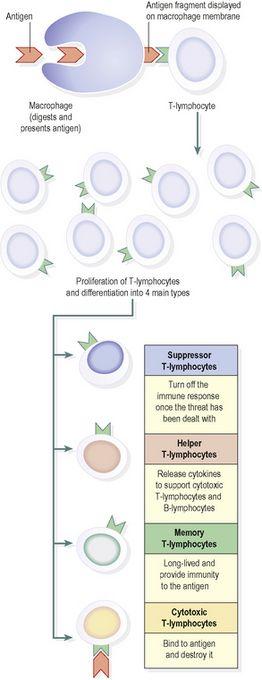Ross & Wilson Anatomy and Physiology in Health and Illness (173 page)
Read Ross & Wilson Anatomy and Physiology in Health and Illness Online
Authors: Anne Waugh,Allison Grant
Tags: #Medical, #Nursing, #General, #Anatomy

After studying this section, you should be able to:
discuss the roles of the different types of T-lymphocyte in providing cell-mediated immunity
describe the process of antibody-mediated immunity
distinguish between artificially and naturally acquired immunity, giving examples of each
distinguish between active and passive immunity, giving examples of each.
The body’s first line of defence is its non-specific defences, including phagocytes such as macrophages. If these are overwhelmed, activation of the powerful immune system follows. Immunity possesses two key attributes not seen with non-specific defences: specificity and memory.
Specificity
Unlike mechanisms such as the inflammatory response and the phagocytic action of macrophages, which are triggered by a wide range of threats, an immune response is directed against one antigen and no others.
Memory
Again, unlike general defence mechanisms, an immune response against a particular antigen will usually generate immunological memory of that antigen. This means that the immune response on subsequent exposures to the same antigen is generally faster and more powerful.
The cell type involved in immunity is the lymphocyte (
p. 63
). This long-lived white blood cell is manufactured in the bone marrow, and has a characteristically large, single nucleus. Once released into the bloodstream from the bone marrow, lymphocytes are further processed to make two functionally distinct types: the T-lymphocyte and the B-lymphocyte.
For each of the millions of possible antigens that might be encountered in life, there is a corresponding T- and B-lymphocyte programmed to respond to it. There are, therefore, vast numbers of different T- and B-cells in the body, each capable of responding to only one antigen (antigen specificity).
T-lymphocytes
These are processed by the thymus gland (
p. 132
), which lies between the heart and the sternum. The hormone thymosin, produced by the thymus, is responsible for promoting the processing, which leads to the formation of fully specialised (differentiated), mature, functional T-lymphocytes. It is important to recognise that a mature T-lymphocyte has been programmed to recognise only one type of antigen, and during its subsequent travels through the body will react to no other antigen, however dangerous it might be. Thus, a T-lymphocyte manufactured to recognise the chickenpox virus will not react to a measles virus, a cancer cell, or a tuberculosis bacterium.
T-lymphocytes provide
cell-mediated immunity
, discussed below.
B-lymphocytes
These are both produced and processed in the bone marrow. They produce antibodies (immunoglobulins), which are proteins designed to bind to, and destroy, an antigen. As with T-lymphocytes, each B-lymphocyte targets one specific antigen; the antibody released reacts with one type of antigen and no other. B-lymphocytes provide
antibody-mediated immunity
, discussed below.
Cell-mediated immunity
T-lymphocytes that have been activated in the thymus gland are released into the circulation. When they encounter their antigen for the first time, they become sensitised to it. If the antigen has come from outside the body, it needs to be ‘presented’ to the T-lymphocyte on the surface of an antigen-presenting cell. There are different types of antigen-presenting cell, including macrophages. Macrophages are part of the non-specific defences, because they engulf and digest antigens indiscriminately, but they are a crucial ‘link’ cell between initial non-specific defences and the immune system. After digesting the antigen they transport the most antigenic fragment to their own cell membrane and display it on their surface (
Fig. 15.3
). They display (
present
) this antigen to the T-lymphocyte that has been processed to target that particular antigen, which results in activation of the T-cell.
Figure 15.3
Clonal expansion of T-lymphocytes.
If the antigen is an abnormal body cell, such as a cancer cell, it too will be displaying foreign (non-self) material on its cell membrane that will stimulate the T-lymphocyte. Whichever way the antigen is presented to the T-lymphocyte, it stimulates the division and proliferation (
clonal expansion
) of the T-lymphocyte (
Fig. 15.3
). Four main types of specialised T-lymphocyte are produced, each of which is still directed against the original antigen, but which will tackle it in different ways.
Memory T-cells
These long-lived cells survive after the threat has been neutralised, and provide
cell-mediated immunity
by responding rapidly to another encounter with the same antigen.
Cytotoxic T-cells
These directly inactivate any cells carrying antigens. They attach themselves to the target cell and release powerful toxins, which are very effective because the two cells are so close together. The main role of cytotoxic T-lymphocytes is in destruction of abnormal body cells, e.g. infected cells and cancer cells.
Helper T-cells
These are essential not only for cell-mediated immunity, but also antibody-mediated immunity. Their central role in immunity is emphasised in situations where they are destroyed, as by the human immunodeficiency virus (HIV). When helper T-lymphocyte numbers fall significantly, the whole immune system is compromised. T-helpers are the commonest of the T-lymphocytes; their main functions include:
•
production of special chemicals called
cytokines
, e.g. interleukins and interferons, which support and promote cytotoxic T-lymphocytes and macrophages
•
cooperating with B-lymphocytes to produce antibodies; although B-lymphocytes are responsible for antibody manufacture, they require to be stimulated by a helper T-lymphocyte first.
Suppressor T-cells
These cells act as ‘brakes’, turning off activated T- and B-lymphocytes. This limits the powerful and potentially damaging effects of the immune response.
Antibody-mediated (humoral) immunity


